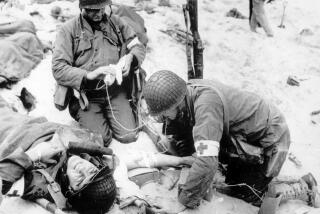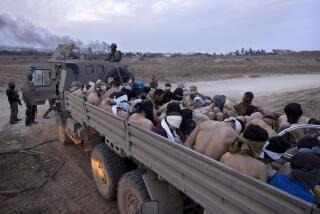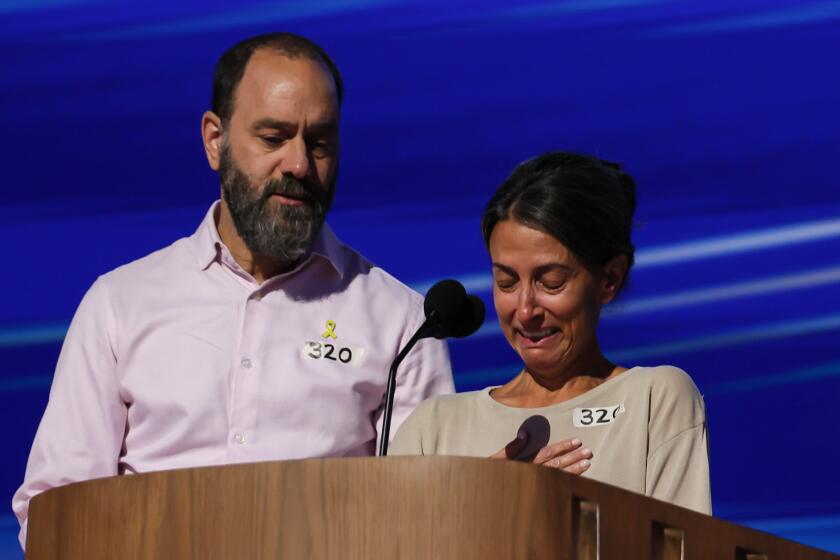Healing Iraq
MOSCOW — The patient was an older Iraqi man breathing so fast he couldn’t say three consecutive words to the interpreter. But a coherent medical history wasn’t necessary to make a diagnosis. His lips were dark blue. He sat bolt upright, pressing his hands into the table to help expand his rib cage. His neck veins bulged, and he wheezed and crackled with every breath. His ankles were grotesquely swollen. Whatever else his problems, he was clearly in heart failure.
We administered Lasix, digoxin and an intravenous dose of aminophylline. We gave him oxygen, drew blood and checked his blood pressure. Three hours later, his respiration rate was down and the terror was gone from his eyes. After two days in the 912th Mobile Army Surgical Hospital in Safwan, southern Iraq, he was well enough to return to his refugee camp, but not before showering me with what seemed to be very grateful Arabic and many slobbering kisses.
The situation in Iraq today is not what it was in 1991, when the MASH unit I was attached to routinely assisted ill civilians whose lives had been disrupted by the Gulf War. I can’t help but wonder whether, if there had been more operations like ours this time out, we might not be so reviled by Iraqis today.
In 1991, more than a dozen field hospitals and their personnel were ready to deploy to provide medical care to civilians. It’s not like things were perfect then: Getting military brass to let us go in and do our jobs was difficult. Frustrated that we’d been left cooling our heels in Saudi Arabia for too long, I called the office of Medical Command in Riyadh to complain. I was told bluntly that “if we send military assistance to the civilian population, then the U.N., the Red Cross, the Red Crescent and other civilian agencies will stop trying to help them, and we will be stuck with them.”
But then, less than a month after the cease-fire, the command abruptly changed its mind and sent three MASH units, including mine, north to treat civilian refugees.
Tens of thousands of people who had fled either the war or Saddam Hussein’s subsequent attacks on his own people poured into Safwan, so the 912th had its hands full. We treated starving children, pregnant women and adults with diabetes and heart failure. Our civil affairs lieutenant colonel, a pediatrician from Arkansas, worked tirelessly with locals to reopen the local civilian clinic. He was derisively called a “loose cannon” by high-ranking personnel at MedCom.
In recent months, the United States has worked hard to get the electrical grid running and the oil flowing in Iraq. But nothing could have helped the U.S. image more than a timely deployment of American Army hospitals to help a population bereft of basic medical care. Had a higher priority been given early to rejuvenating the medical infrastructure than to pumping oil, we might now need fewer U.S. soldiers to keep the peace -- and we might see more oil being pumped as well.
The Army Medical Corps has developed a tremendously effective ability to treat people in war-torn areas. The quality and availability of American medicine is admired everywhere in the world, and Army hospitals are capable of bringing American “dream world” medicine to desperate people and their relatives. Army field hospitals can also provide services beyond surgery and outpatient treatments, including meals, shower and laundry facilities, and communications equipment. In less than two months in 1991, two U.S. field hospitals handled more than 200 surgeries, 500 hospitalizations and 17,000 outpatient visits. A tiny percentage of the problems were combat-related. The rest were the routine stuff of any medical practice. Saving the life of a child may be routine for an American hospital, but it had a big effect in Safwan.
After Desert Storm, several reserve and National Guard hospitals were deactivated as superfluous. Only one MASH unit remains, and the Army has replaced the self-sufficient MASH model with battlefield surgery teams working in concert with hospital facilities located farther from the front. This was shortsighted because military hospitals, standing alone or augmenting civilian facilities, constitute a great potential weapon for waging peace.
I do not deprecate the use of smart bombs. But if we can afford smart bombs to shorten a war, can we afford not to use military hospitals for emergency care to help win the peace? We have Air Force officers well trained to shoot things down and blow things up. But the American military has another kind of officer too: doctors.
I still remember a diabetic young mother who arrived at our hospital on a stretcher. She was awake but feverish and very tired. Her mouth was dry and her breathing labored. Her swollen left foot was clearly infected. Through the interpreter, she related that insulin supplies had been unavailable since the U.S. bombing began in January. Her last dose had been three weeks earlier.
Within three days of admission her temperature, blood sugar and acidosis were controlled. She lost part of her foot to the surgeons, but a week later she left the 912th on crutches, smiling, with her son at her side.
We saved that woman’s life and the lives of many others as well. We treated heart failure, removed inflamed appendixes and delivered babies. We worked hard but were rewarded with immeasurable gratitude. And that is something that’s in short supply for Americans in Iraq today.
More to Read
Sign up for Essential California
The most important California stories and recommendations in your inbox every morning.
You may occasionally receive promotional content from the Los Angeles Times.










